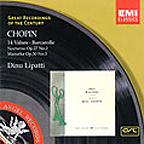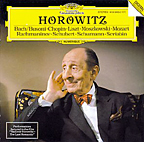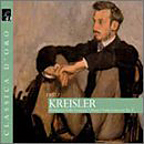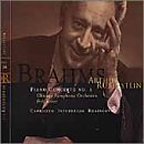100 Definitive Recordings by Norman Lebrecht
/ September 22, 2005
Here
are the most recent installments of Norman Lebrecht's 100 Definitive Recordings
Visit http://100CDs.scena.org
weekly.
CD 47: Chopin: Waltzes
Dinu Lipatti
EMI: Radio Geneva studios, July 1950
 The
Romanian pianist, just 33 when he died, made his precious few recordings while
suffering from leukemia, but there is nothing of the sickbed about his
blistering performances. Lipatti's crisp, witty articulation dispels the image
of Chopin as a morbid melancholic, though neither man remained long in this
world. There is a devilment to the playing, an almost improvisatory approach
that derives from Lipatti's private passion for hot jazz. The
Romanian pianist, just 33 when he died, made his precious few recordings while
suffering from leukemia, but there is nothing of the sickbed about his
blistering performances. Lipatti's crisp, witty articulation dispels the image
of Chopin as a morbid melancholic, though neither man remained long in this
world. There is a devilment to the playing, an almost improvisatory approach
that derives from Lipatti's private passion for hot jazz.
A powerfully-built man of wealthy parentage, he spent
the late 1930s in Paris with Alfred Cortot and Nadia Boulanger but wound up
starving in Switzerland in 1943. The Geneva Conservatoire gave him a job and
EMI a record deal, but he was already deathly pale. The arrival of the drug
Cortisone in the summer of 1950 gave him a burst of energy and optimism that
made even the moody Chopin waltzes in minor keys sparkle with high spirits.
Sadly the remission was shortlived and he was gone by Christmas. Unique among
star pianists, Lipatti always let the music speak for itself.
CD 48: Horowitz
DG: NY, April 1985
 Vladimir
Horowitz had more comebacks than Lucifer. Every decade or so, the demons would
take over and he would be medicated or hospitalized out of circulation. Manic
depressive and awkwardly gay, he was the epitome of the wacko pianist, living
on a diet of boiled fish and playing only at 4:30 in the afternoon. He was also
the most natural of artists, blessed with a touch that defied gravity and
extended notes beyond the remit of pedal power: once heard, never forgotten. Vladimir
Horowitz had more comebacks than Lucifer. Every decade or so, the demons would
take over and he would be medicated or hospitalized out of circulation. Manic
depressive and awkwardly gay, he was the epitome of the wacko pianist, living
on a diet of boiled fish and playing only at 4:30 in the afternoon. He was also
the most natural of artists, blessed with a touch that defied gravity and
extended notes beyond the remit of pedal power: once heard, never forgotten.
His final comeback, in his 82nd year, was captured on
film by the Maysles brothers and on disc by his lifelong RCA producer John
Pfeiffer, on hire to DG. The session in his Upper East Side apartment took six
afternoons and evenings, but Horowitz sounded as fresh throughout as he had
when he first burst onto the scene in 1920, springing from Russia with his
lifelong pal, violinist Nathan Milstein, by order of Lenin's culture commissar.
No pianist has ever taken the Busoni transcription of
a Bach chorale so slowly, revealing the giant edifice behind it, nor has
anyone, the composer included, filled Rachmaninov's G# minor prelude with such
foreboding. Mozart and Chopin are treated as if they were Horowitz's
contemporaries, tormented romantics in a bewildering world. This is the last
great record of a virtuoso recital, and its location, in the pianist's living
room, provides an almost unbearable intimacy.
CD 49: Beethoven violin concerto
Fritz Kreisler
HMV: Berlin, September 1926
 The
sweet-toned Fritz Kreisler is revered by violinists as diverse as Nigel Kennedy
and Maxim Vengerov. In a recent study called Capturing Sound: How Technology has
Changed Music (University of California Press), author Mark Katz
credits him with changing the way violinists play in the recording studio,
keeping up a long vibrato throughout the work. His cadenza for the Beethoven
concerto – the part where soloists are expected to let their hair down – was
adopted as standard by less fertile violinists; so much so that Hitler was
unable to ban it and merely had Kreisler's name expunged from programmes. The
sweet-toned Fritz Kreisler is revered by violinists as diverse as Nigel Kennedy
and Maxim Vengerov. In a recent study called Capturing Sound: How Technology has
Changed Music (University of California Press), author Mark Katz
credits him with changing the way violinists play in the recording studio,
keeping up a long vibrato throughout the work. His cadenza for the Beethoven
concerto – the part where soloists are expected to let their hair down – was
adopted as standard by less fertile violinists; so much so that Hitler was
unable to ban it and merely had Kreisler's name expunged from programmes.
Viennese by birth and temperament, Kreisler had a
sunny disposition, twinkling through happy passages and dancing at the very
edge of schmaltziness in sentimental pieces. In Beethoven, however, he was
austere, aware of the immensity of the concerto and his own contribution to its
legend. With Leo Blech and the Berlin opera orchestra, his approach is
measured, unflustered and entirely unostentatious. Personal quirks are
imperceptible and every note is set firmly in its place, as if he intended this
to be a record for all time.
As for the cadenzas, they do exactly what the composer
expected – reflect back on what has just been played and extrapolate putative
alternatives. Kreisler's is the benchmark account of this concerto and, though
he rerecorded it with better sound in London ten years later, the original is
unsurpassably concentrated.
CD 50: Brahms: 1st piano concerto (D minor)
Artur Rubinstein/Chicago SO/Reiner
RCA: Chicago, April 17, 1954
 Beaten
by CBS to launching the LP, RCA got in first with stereo. After experimental
sessions in New York with the audio-conscious Leopold Stokowski, the engineers
went to Boston to capture a Berlioz Damnation of Faust with Charles Munch. The
results were spacious but ill-defined beside a good mono recording. On they
went to Chicago, where the orchestra had a tough new music director in Fritz
Reiner, and the label's top-selling pianist, Artur Rubinstein, to play the
first Brahms concerto. Beaten
by CBS to launching the LP, RCA got in first with stereo. After experimental
sessions in New York with the audio-conscious Leopold Stokowski, the engineers
went to Boston to capture a Berlioz Damnation of Faust with Charles Munch. The
results were spacious but ill-defined beside a good mono recording. On they
went to Chicago, where the orchestra had a tough new music director in Fritz
Reiner, and the label's top-selling pianist, Artur Rubinstein, to play the
first Brahms concerto.
Conductor and soloist did not see eye to eye – they
rowed over Reiner's imputation that Chopin had been gay – but, aware of the new
technology, they produced a performance in which orchestral colours sparkled
and glowed, and the piano was set realistically, centre-left, instead of far
ahead of the band, as Rubinstein preferred. The technical team taped the
performance on three microphones, each wired to a separate channel, overcoming
the boxiness of previous attempts. This was the recording where stereo came of
age. It took another four years before the format was released; the record
industry was forced to wait for domestic hi-fis to catch up.
|
|


